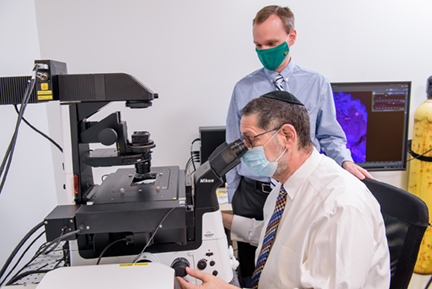 The UAB Department of Ophthalmology and Visual Sciences and the UAB Department of Optometry are pleased to announce the acquisition of a new Nikon AXR Confocal Microscope, making UAB one of the first academic centers in the United States and first in the Southeast region to house this state-of-the-art technology. With advanced artificial intelligence built into many aspects of its function, the Nikon AXR Confocal Microscope greatly simplifies microscope setup and leads to the most optimal images for research.
The UAB Department of Ophthalmology and Visual Sciences and the UAB Department of Optometry are pleased to announce the acquisition of a new Nikon AXR Confocal Microscope, making UAB one of the first academic centers in the United States and first in the Southeast region to house this state-of-the-art technology. With advanced artificial intelligence built into many aspects of its function, the Nikon AXR Confocal Microscope greatly simplifies microscope setup and leads to the most optimal images for research.
The addition of this microscope was made possible through the combined funds from the NIH P30 Vision Core Grant used by the departments, along with the Vision Science Research Center (VSRC). The P30 Center Core Grant supports UAB vision scientists’ four research support cores, which provide a variety of services at centralized locations on campus, ranging from comprehensive data analysis to basic equipment repair.
“This instrument is one of the most significant investments the P30 has made in its lifetime and should advance vision science discoveries in laboratories of researchers across campus,” said Brian Samuels, MD, PhD, associate professor of ophthalmology, Dennis Endowed Professor in Glaucoma Research, and P30 director.
The microscope will be utilized in various ways as the research teams look to gain a better understanding of many eye conditions. “The microarchitecture of anterior and posterior ocular structures and brain structures will be studied and applied to the understanding of diseases such as glaucoma and retinal degeneration, including age related macular degeneration (AMD), retinitis pigmentosa (RP), and diabetic retinopathy,” said Steven Pittler, PhD, director of the Vision Science Research Center.
The P30 Center Core Grant, which was renewed in 2020, has continuously helped fund UAB’s vision research since the VSRC was founded in 1979. One of 24 UAB university-wide interdisciplinary research enters, the VSRC was established to draw together vision scientists from the entire campus. There are currently more than 82 appointed faculty members representing 17 departments and five schools at UAB and at the Birmingham VA Medical Center.
“We are in a unique position to have accumulated significant unused funds over the previous year as we worked to move all of the cores to a centralized location,” said Samuels. “We owe a great deal of gratitude to Drs. Nichols, Girkin, and Pittler for their generosity in matching these unused funds to cover the cost of this instrument. Without their combined support, this investment would not have been possible. This instrument will likely become a cornerstone for research laboratories across the UAB campus for years to come, as well as be an attractive resource that will help us recruit some of the most sought-after vision scientists to UAB.”